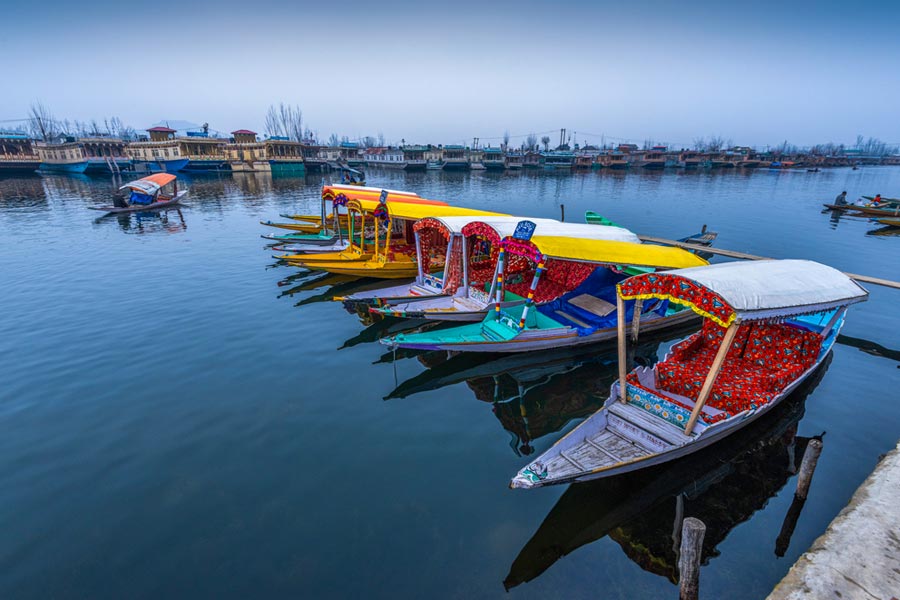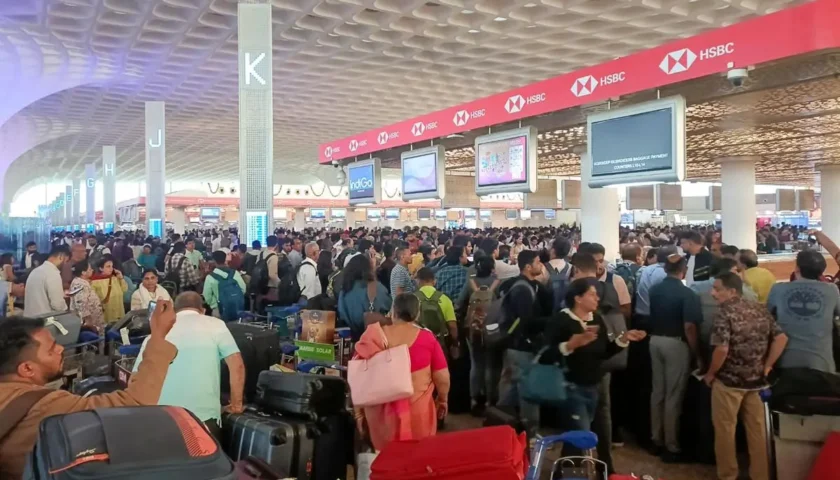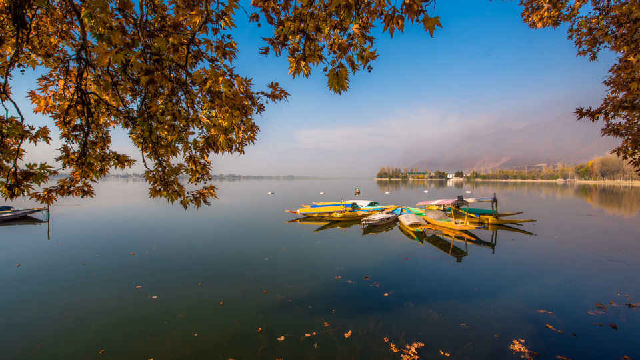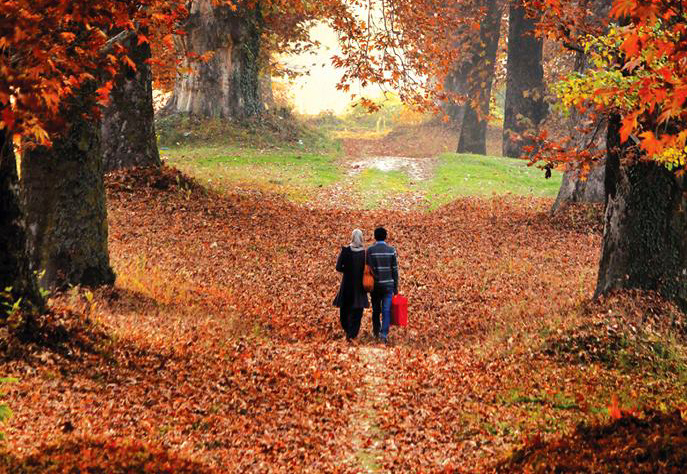Jammu & Kashmir Economy 2025 | Tourism, Transport, Horticulture in Crisis
By: Javid Amin | 29 October 2025
A Region in Economic Freefall
The union territory of Jammu & Kashmir (J&K) is experiencing what can only be described as a deepening economic crisis in 2025. Once heralded as the “Paradise on Earth” with a booming tourist economy, vibrant horticulture (especially apples) and a thriving informal trade network, the region now finds many of its key sectors reeling from a cascade of shocks.
From air and road transport disruptions to landslides, from tourism footfall collapse to horticulture losses, J&K’s economic ecosystem is under acute stress. The ripple-effects are severe: jobs lost, investment stalled, local businesses shuttering, informal livelihoods eroded.
In short: one of India’s most picturesque regions is facing one of its most significant economic downturns — with human consequences for the thousands of families who depend on sectors that once flourished.
In the following sections we unpack: the scale of the collapse, the structural fault-lines underneath it, the lived reality on the ground, and what needs to be done to reverse the slide.
The Tourism Collapse: Once a Lifeline, Now a Liability
01. A Brief Background: How Tourism Propelled J&K
Tourism has long been a central pillar of J&K’s economy. From the houseboats of Dal Lake in Srinagar to the ski slopes of Gulmarg, from the pilgrimage trails of Vaishno Devi to the scenic meadows of Pahalgam, the region built a strong brand for domestic and international travellers.
According to studies, in 2023–24 J&K recorded roughly 2.3 crore (23 million+) tourist visits. In particular, after the abrogation of Article 370 in 2019, increased infrastructure investment and renewed marketing boosted expectations.
Hotels, transport services, houseboats, handicraft vendors and informal seasonal workers all benefitted. Tourism created multiplier effects: hospitality drove demand for local food-supplies, transport, entertainment, paraphernalia and regional labour.
02. The Plunge: Ground Reports of Occupancy Collapse
Yet in 2025 the picture has reversed dramatically. Ground reports confirm a near-collapse of the tourist economy in the Kashmir division:
-
One report notes that tourist arrivals dropped from 1,79,342 visitors in April to just 6,951 by mid-May in the valley.
-
Hotels in the valley are now operating at occupancy rates below 20%.
-
Reports cite booking cancellations of the order of 70–95% for upcoming seasons.
-
According to official data, in Jan–June 2025 J&K recorded 95.9 lakh domestic tourist visits and 19,570 foreign tourists — which is significantly lower compared to past years.
These figures clearly signal: tourism in J&K has not simply “slowed” — it has entered a crisis mode.
03. What Triggered the Crash? Multiple Drivers
The tourism plunge in J&K is not the result of a singular issue. Rather, a convergence of factors has created a “perfect storm.” Some of the major triggers:
Security & Perception Risk
A key flashpoint: the terror attack in April 2025 near Pahalgam, where 26 tourists (mostly Indian) were killed. That incident triggered widespread cancellations and amplified perceptions of insecurity. Tourist sites were shut as a precaution. Occupancy collapsed. What had been perceived as a safe holiday destination suddenly appeared vulnerable.
Logistical & Infrastructure Vulnerabilities
Even for willing tourists, J&K presents access risks. The arterial National Highway 44 (Jammu-Srinagar) is prone to landslides, snowfall closures and traffic congestion. These disruptions erode reliability — which is a major deterrent for travellers who prefer certainty. Ground reports cite that access and road-blocks amplify fear and cancellations.
Economic Domino Effects
When tourist numbers drop, the whole hospitality value-chain is hit: hotels reduce staff, taxi operators idle, houseboats sit empty, restaurants near tourist hubs suffer. This ripple extends into the informal economy (vendors, guides, pony-ride operators) which has less resilience to absorb shocks.
Confidence Erosion & Demand Shock
Tourism is as much about perception as reality. Once the narrative turns “unsafe” or “uncertain”, recovery is slow. As one local vendor described: “We sit all day, waiting for tourists who never come.” Ground reports emphasise this demand-shock view.
04. Lived Reality: Voices from the Ground
The human dimension of this collapse is stark.
-
A shikara operator on Dal Lake reported his boats tied up, earning virtually nothing.
-
Hotel-owners in Srinagar speak of losses of tens of lakhs and staff layoffs. One sample hotel had only 2 of 45 rooms occupied during what should have been the peak season.
-
Street-vendors, handicraft shops and restaurants near tourist circuits report near-zero footfall and sliding revenues.
-
Informal workers — guides, pony-owners, houseboat crews — lack formal contracts or social security buffers, making their incomes dramatically vulnerable.
05. Wider Economic Impact of the Tourism Collapse
The tourism downturn is not confined to hospitality — it spills into the broader economy:
-
Local governments lose tax and fee revenue (hotel tax, tourism fees, etc.).
-
Downstream industries (transport, catering, linen supply, handicrafts) see lower demand.
-
Unemployment rises, especially in areas reliant on seasonal tourist flows.
-
Investment plans, new hotels, infrastructure projects get deferred as investor confidence weakens.
-
The overall regional growth rate suffers due to the contraction in the services sector (which, in J&K, contributes 60-odd %+ of the economy).
06. Why the Bounce-back is So Slow
Although tourism sectors are accustomed to seasonal dips, the depth and breadth of the current crisis make recovery unusually difficult:
-
Perception takes time to rebuild; one adverse incident may reverberate for years.
-
Some destinations remain partially closed or under restricted access due to security/logistics — this sends conflicting signals to potential tourists.
-
Operators face immediate cash-flow stress: hotels still have maintenance, staff and overhead costs despite low occupancy; without relief, closures become inevitable.
-
Competitor destinations (e.g., Himachal, Uttarakhand) are aggressively marketing and may capture diverted tourist flow.
-
Inadequate or fragmented marketing efforts in J&K hamper rebuilding of brand confidence.
Transportation & Infrastructure: The Artery of Collapse
01. Transport Sector Under Pressure
Transport (road, air, intermediate public transport) is a critical enabler for tourism, horticulture and informal trade. In J&K this sector is under serious strain.
-
Flights into major airports (Srinagar Airport, Jammu Airport) are still operating below last year’s levels. Business Standard
-
Road-access remains fragile: the Jammu-Srinagar highway experiences frequent closures due to landslides, snowfall, security movements. These disruptions affect mobility of tourists and goods alike.
-
Transporters report inconsistent demand: bookings for tourist-vehicles are down sharply; for horticulture logistics the delays and closures mean perishable produce spoil.
02. Infrastructure Fault-Lines in the Region
The physical geography of J&K — mountainous terrain, high altitude, narrow valleys — means infrastructure is always under pressure, even without extra shocks. Key issues:
-
Highway closures & landslides: The Jammu–Srinagar axis is often the only reliable ground link; when it shuts, the ripple is dramatic.
-
Air-connectivity bottlenecks: Weather, security restrictions, and reduced demand limit optimised flight schedules.
-
Technology & digital gaps: While infrastructure has improved in places, many rural and off-beat destinations still lack robust connectivity, making them high-risk for tourists.
-
Maintenance deficits: Given the difficult terrain, infrastructure requires high maintenance; economic stress may mean such upkeep is delayed.
-
Perishables logistics: Transport for horticulture (especially apples) demands speed and reliability; any breakdown raises spoilage risk.
03. Consequences for the Economy
When transport and infrastructure falter, the consequences are multi-fold:
-
For tourism: Access risks deter bookings; the region no longer promises “easy” travel.
-
For horticulture and agriculture: Fresh produce cannot be moved promptly; spoilage and margin-loss increase.
-
For informal trade and market supply: Vendors, local markets, roadside stalls suffer because incoming supply of goods becomes delayed or expensive; consumer demand falls.
-
For investment: Investors view transport and infrastructure risk as a deterrent; capital gets redirected elsewhere.
-
For everyday livelihoods: When transporters, truck-drivers, taxi operators lose work, their incomes shrink, creating broader socio-economic distress.
04. The Ripple Towards Other Sectors
Transport is therefore not just a sector—it is a linchpin connecting multiple sectors:
-
Horticulture depends on logistics for export/distribution.
-
Tourism depends on connectivity and accessibility.
-
Informal trade and local markets depend on supply-chains reaching them and customers reaching them too.
-
Infrastructure weakness increases operating costs, reduces investor confidence, and exacerbates risk perceptions.
In short: the transport-infrastructure breakdown is a major contributor to the overall economic freefall in J&K.
Horticulture & Perishables: The Apple Industry’s Blow
01. Why Horticulture Matters
In J&K’s economy, horticulture—especially apple cultivation—has been a key driver of rural livelihoods, seasonal employment, and linkages into broader supply chains. It also offers export potential, and value-addition opportunity (packing, cold storage, transport).
02. The Crisis in Apples—Logistics and Weather Combine
Recent ground reports highlight that apple growers in Kashmir are facing severe losses:
-
According to an international media report, apple growers in Kashmir faced losses estimated at around ₹ 600 crore to ₹ 700 crore (~US$ 68–79 million) due to road closures and flood/landslide disruptions in the peak harvest season.
-
Packaging costs surged — one grower reported a carton cost rising from ₹ 40 to ₹ 200 due to delays and logistic bottlenecks.
-
Heavy rains and flash floods have destroyed orchards, trees and ripening fruit in South Kashmir.
03. Administrative Delays & Market Access Issues
Beyond weather and logistics, growers face institutional and market-related bottlenecks:
-
Delayed clearance at administrative or transport checkpoints adds spoilage risk.
-
Alternative routes (such as the Mughal Road) are unreliable or limited capacity.
-
Cold-chain / storage facilities remain inadequate in many orchard-zones.
-
Many growers are small/horticulture households with limited buffer to absorb losses; they may rely on bank-loans, seasonal labour, and repayment schedules that assume normal harvests.
04. Multiplier Impact of Horticulture Collapse
When horticulture falters:
-
Seasonal labourers (packing, loading, transport) lose work.
-
Transporters lose business.
-
Downstream businesses (cold storage, sorting, packaging plants) shrink.
-
Local markets and vendors face reduced supply and elevated costs; this translates to higher consumer prices, fewer sales, and wealth-erosion.
-
Rural indebtedness increases; when yields fail, repayments become difficult, triggering financial stress and potential defaults.
05. Link with Tourism and Transport
There is a direct interplay: tourism decline reduces demand for local horticulture produce (hotels purchase apples, restaurants buy local fruit). Transport disruptions that hit apples also coincidentally impact tourism logistics (road closures, landslide risks). Thus the horticulture problem is not silenced—it amplifies the region’s broader economic distress.
06. A Window to Re-Think Horticulture Strategy
Moving forward, addressing horticulture’s collapse involves:
-
Creating alternative logistic corridors or cold trains (rail-parcel services).
-
Strengthening cold-chain, storage and value-addition (sorting, processing).
-
Diversifying crops and horticulture practices to reduce dependency on apples alone.
-
Linking horticulture with agritourism or farm-stays, integrating with tourism revival.
-
Providing financial relief or buffer-funds to growers for weather/logistic shocks.
Informal Trade, Hospitality & Local Markets: The Hidden Cascades
01. The Informal Economy: More than Just Numbers
Much of J&K’s economic activity lies in the informal sector: street vendors, Sunday markets, shikara-operators, houseboat staff, pony-rides, small restaurants, tea-shops, roadside stalls. These actors are often overlooked in macro-economic statistics but they are central to livelihoods and community resilience.
02. Impacts of the Economic Downturn on Informal Workers
What is happening on the ground?
-
Vendors in tourist areas (boulevards, houseboat precincts, lakeside shops) report near-zero footfall due to tourism collapse. At one prominent lakeside boulevard road, a toy-selling child was the only presence when tourists once queued by the dozens.
-
Restaurants and local eateries are shutting down at alarming rates because of adulterated supply, fewer local diners and declining tourist spending.
-
Informal transport providers (taxi drivers, shikara operators, pony guides) face inconsistent demand and lack of social safety nets. One hotel-owner reported being forced to retrench most of his 15-member staff.
-
Some Sunday markets and informal vendors have come under scrutiny due to rising skin-infections and hygiene concerns in the region; public trust in informal trade has eroded. This both reduces vendor income and increases regulatory risk for informal actors.
03. The Social Effects: Livelihoods, Poverty Trap, Migration Risk
The informal economy carries deep social consequences when under stress:
-
Loss of income for low-income families: Informal workers often have little savings, volatile cash flows and high upfront costs (e.g., equipment rental, permit fees).
-
Increased indebtedness: When business drops off, loans remain. Many may default or borrow further—risking a poverty-trap.
-
Migration pressure: Youth may seek work elsewhere (outside the region) or opt for irregular jobs, eroding local human-capital and increasing social stress.
-
Gender and social equity: Many informal workers are women (vendors, helpers) or seasonal labourers; downturns hit these groups harder and more invisibly.
-
Informal health risk: With lower incomes and fewer clients, informal trade may cut corners on hygiene/safety, increasing public health concerns and further reducing confidence in these markets.
04. Hospitality Spill-Over: Small Restaurants, Houseboats, Guesthouses
Beyond big hotels, small hospitality players are especially vulnerable:
-
Houseboats on Dal Lake: their incomes hinge on tourists. With bookings down, owners still have maintenance and mooring costs—many may be forced to halt operations.
-
Guesthouses and home-stays: Less formal, fewer buffers, more vulnerable to cancellations.
-
Local restaurants: With fewer diners (both tourist and local), margins shrink; combined with rising supply costs and adulteration concerns (making sourcing harder), many are closing.
-
Skilled/unskilled staff: Many hospitality workers are on daily wages or temporary contracts; losses of jobs hit quickly, and there is limited unemployment safety net in the region.
05. Policy Blind-Spots for Informal Sector
One of the major fault-lines: informal sector actors often fall between policy-cracks. They may not have formal registration, be outside relief programmes, lack insurance or social security benefits. When the shock comes, the safety net is weak or absent.
Thus any economic revival must explicitly include the informal economy—not just the big hotels or transport companies but also the countless micro-actors who animate the region’s economy.
Structural Fault-Lines: What’s Really Weak in the System
01. Political & Administrative Uncertainty
-
Debates around reservation, land-ownership, administrative restructuring and investor confidence have created a climate of policy uncertainty in J&K. When investors are unsure of framework, capital hesitates.
-
The region’s governance environment remains sensitive: security concerns, central-state dynamics, local perceptions all add to the backdrop of uncertainty.
-
When policy makers are distracted by political debate rather than economic revival, the response to shocks is delayed or fragmented.
02. Climate Shocks & Environmental Vulnerabilities
J&K’s mountainous geography makes it highly vulnerable to climate-change impacts:
-
Spring floods, cloud-bursts, erratic snow-fall disrupt agriculture, roads, transport and tourism calendars. For example, the flash-flood in South Kashmir (Chositi village, Kishtwar district) in August 2025 killed dozens, affecting local livelihoods and supply-chains.
-
Landslides and highway closures triggered by weather patterns amplify transport-risk.
-
Agriculture and horticulture suffer when growing seasons shift, irrigation fails, or logistic windows shrink.
-
Tourism too is sensitive to weather disruptions: accessibility, season-timing, scenic appeal all change with climate shocks.
03. Policy Blind-Spots and Delayed Interventions
-
Relief for affected sectors often lags. For example, despite major tourist drop, the government admitted that no formal assessment of business losses had been completed.
-
Safety-nets for small businesses, transporters, informal workers are weak or not tailored to mountain-region needs.
-
Logistics and cold-chain support for horticulture remain under-developed.
-
Tourism revival plans exist, but execution, coordination with local actors, digital marketing, infrastructure upgrades are still piecemeal.
04. Over-Dependence & Lack of Diversification
-
J&K’s economy is heavily reliant on a few sectors (tourism, horticulture, transport). With these getting hit together, the system lacks cushion.
-
The seasonal nature of tourism and horticulture increases vulnerability to calendar-shocks.
-
Lack of value-addition in horticulture (apart from raw apple shipments) means local value-capture is low; when transport/logistics fail, much is lost upstream.
-
Informal trade remains weakly integrated into formal value chains; when business shrinks, the linkages break down quickly.
05. Investor Confidence & Capital Flows
When structural fault-lines accumulate:
-
Investors perceive risk: security risk, infrastructure risk, climate risk, logistic risk.
-
Projects get delayed or cancelled; new hotel builds, logistic park development, cold-chain infrastructure investment slow or freeze.
-
Local entrepreneurs may postpone expansion or diversify elsewhere.
-
Public-private partnerships may suffer from uncertainty or weak demand projections.
Taken together, these structural weaknesses mean that the economic shock in J&K is not just Cyclical (temporary downturn) but potentially Structural (a deeper transformation and need for recalibration).
What Needs Urgent Attention: A Roadmap for Revival
Given the scale and depth of the stress, revival cannot rely on “business-as-usual”. It needs targeted, coordinated, multi-sectoral action. Here are what I identify as key levers of reform.
01. Targeted Relief for Small Businesses (Hospitality & Transport)
-
Emergency subsidies/grants: The government should provide bridge-funding to hotels, houseboats, guesthouses, taxi/tour-vehicle operators, shikara owners—to keep them afloat until tourist confidence rebuilds.
-
Loan restructuring: Banks/NBFCs should allow moratoria or restructure loans of small enterprises in tourism/hospitality/transport sectors.
-
Insurance & guarantee schemes: For transporters and small operators facing revenue collapse, introduce subsidised insurance or risk-sharing.
-
Training & support: Upskilling staff in hospitality operations (digital booking, hygiene protocols, alternative product offerings) to re-align for the post-shock market.
-
Marketing-campaign tie-ups: Link small operators into regional promotional campaigns (packaging local house-stays, adventure tourism, off-beat routes).
02. Streamlined Logistics for Horticulture & Perishables
-
Alternative logistic corridors: Given that the Jammu–Srinagar highway is prone to blockage, the government should accelerate alternative routes (rail-parcel services, cold-chain trucks via alternate roads). For example, there are reports of a parcel train service being launched for apples.
-
Cold-chain investment: Establish modern sorting, grading, cold-storage and packaging hubs near orchard areas so that spoilage risk is reduced.
-
Value-addition: Encourage local processing (apple‐juice, dried apples, packaged snacks) so value-capture happens locally rather than purely raw shipments which are logistic-sensitive.
-
Farmer Safety Net: Provide forward contracts, minimum price guarantees, insurance against logistic/weather disruptions.
-
Digital Market Linkages: Enable growers to connect directly with consumers, online retail, outside of traditional supply-chains which are logistic-fragile.
03. Public Health Regulation of Informal Markets without Criminalising Livelihoods
-
Hygiene & infrastructure support: Sunday markets and informal vendors need basic infrastructure (clean water, waste disposal, sanitary stalls) to rebuild public trust.
-
Vendor formalisation incentive: Provide streamlined registration for informal vendors which enables them to access relief, training, micro-loans while preserving their livelihoods.
-
Safe-market certification: A local certification of “safe vendor/ market” could reassure consumers and improve footfall.
-
Grievance redressal & inclusion: Many informal vendors are ignored in policy-dialogue—establish dedicated forums to include their voice.
-
Social protection linkages: Include informal workers into basic welfare schemes, health insurance, micro-pension frameworks to increase resilience.
04. Transparent Tourism Revival Plans, Including Infrastructure Upgrades & Digital Marketing
-
Brand repositioning & confidence-building: Launch a sustained multi-platform campaign (“Visit J&K 2026”, “Kashmir Re-opens”, etc) which emphasises safety, new experiences (adventure tourism, wellness, domestic segments).
-
Diversification of tourism products: Beyond the usual “pleasant summer valley” model, promote winter tourism, thrill-sports, rural/eco-tourism, cultural-heritage tourism, adventure treks. This lowers seasonal vulnerability.
-
Infrastructure upgrades: Focus on improved access — upgraded roads, alternate routes, better last-mile connectivity, digital infrastructure (booking, payment, reviews).
-
Local-community involvement: Homestays, village tourism initiatives, cultural-experiences ensure local ownership and diversified income.
-
Monitoring & feedback: Establish a tourism-dashboard (real-time arrivals, hotel occupancy, bookings) to detect early signals of decline and respond.
-
Public-private partnership models: More involvement of private sector in hotel/hospitality infrastructure, plus incentives to encourage investment despite current risk perception.
05. Vocational Training & Employment Schemes to Absorb the Youth
-
Skill mapping: Identify the new economy needs (digital marketing for tourism, cold-chain logistics, horticulture value-addition, renewable energy, maintenance of infrastructure) and align training accordingly.
-
Youth employment guarantee schemes: Given that many educated youth in J&K are seeking work, a coordinated employment scheme (on infrastructure, maintenance, tourism-services) would help absorb them and reduce social stress.
-
Entrepreneurship support: Encourage youth to become small-enterprise owners (eco-tourism guides, e-commerce of local craft/horticulture produce, local app-based services) with start-up subsidies, mentorship.
-
Connectivity of rural youth: Since many rural areas are disconnected, targeted schemes for rural youth (mobile repair, tourist-guide training in villages, home-stay management) ensure decentralised employment.
-
Social inclusion: Ensure gender-inclusion, scheduled-tribe/tribal participation, backward-region focus so that revival is equitable across the region.
A Holistic Framework: Putting it All Together
To transform the recovery into a sustainable upward trajectory rather than a temporary rebound, J&K needs a holistic framework:
-
Risk identification & buffer building
-
Map sectors by vulnerability (tourism, horticulture, transport)
-
Establish contingency funds, insurance-pools, logistic-alternatives
-
-
Sector-specific interventions
-
Tourism revival as described
-
Horticulture/logistic strengthening
-
Infrastructure-connectivity (roads, airports, cold-chain)
-
Formalising informal trade
-
-
Institutional coordination & governance
-
A cross-sector task-force (government + business + community) to steer revival
-
Transparent monitoring, publicly-available data dashboards (tourist arrivals, hotel occupancy, highway status, horticulture shipments)
-
Policy continuity and clarity to boost investor confidence
-
-
Diversification & resilience building
-
Promote off-peak tourism (winter, pilgrimage, border-tourism)
-
Develop value-addition in horticulture and craft
-
Invite green/renewable-energy projects as alternative growth nodes in mountain economy
-
-
Community & informal economy inclusion
-
Recognise informal labour, vendors, and small businesses as part of the revival story
-
Link them into formal schemes, training, digital platforms
-
Ensure livelihood protection so the social fabric holds under stress
-
-
Marketing, brand-revival & demand stimulation
-
Aggressive yet realistic marketing targeting domestic (first) and international tourists (later)
-
Build narratives of safety, accessibility, new experiences
-
Leverage social-media, influencers, partnerships with travel-platforms
-
-
Climate & infrastructure adaptation
-
Invest in weather-resistant infrastructure (roads, tunnels, hazard-mapping)
-
Develop early-warning systems for landslides/closures
-
Encourage sustainable tourism practices (eco-tourism, carrying-capacity norms) to protect natural assets
-
Looking Ahead: Opportunities Amid Crisis
Although the current scenario is sobering, there are silver-linings and latent opportunities:
-
The crisis is forcing diversification — reliance on one tourist-model or one crop no longer suffices.
-
Domestic tourist potential remains large — many Indians are exploring domestic escapes; with right positioning, J&K can capture this market.
-
Value-addition in horticulture is overdue — the crisis may accelerate the long-needed shift from raw-shipments to processing, packaging and branded products.
-
New infrastructure announced (alternate logistic routes, cold-chain, tunnels) can pay dividends if executed.
-
Informal economy actors, if supported now, can become formalised enterprises, boosting productivity and resilience.
-
Technology and digitalisation (online bookings, e-commerce of crafts/horticulture, logistic-tracking) can leap-frog traditional constraints.
Bottom-Line: Time for a Reset, Not a Return to the Old Normal
Jammu & Kashmir’s economy is not simply facing a temporary slowdown — it is confronting a systemic stress that demands a reset. The old growth model — booming tourism + high-volume apple shipments + fragile transport chains + informal economy on the side — is proving vulnerable to multi-factor shocks.
What lies ahead is neither automatic recovery nor collapse but a choice: a revival built on resilience, diversification and inclusion. If policy-makers, businesses and communities engage in a coordinated, thoughtful effort now, J&K can rebuild its economy — and make it stronger, more inclusive and more future-proof.
But if the current crisis instead is treated as “business as usual,” the human and economic losses will deepen, livelihoods will erode and the region’s potential may go unfulfilled.
For the thousands of families, small-business owners, vendors, drivers and seasonal workers whose livelihoods are at stake — time is not luxuriously available. The roadmap needs to be implemented, not postponed.
Final word: Jammu & Kashmir deserves—both metaphorically and literally—a revival of its paradise potential. But the path ahead requires clear thinking, structural reform, compassionate policy-making and the intentional inclusion of the informal economy. The only “return to normal” worth aiming for is one that is better than before.




